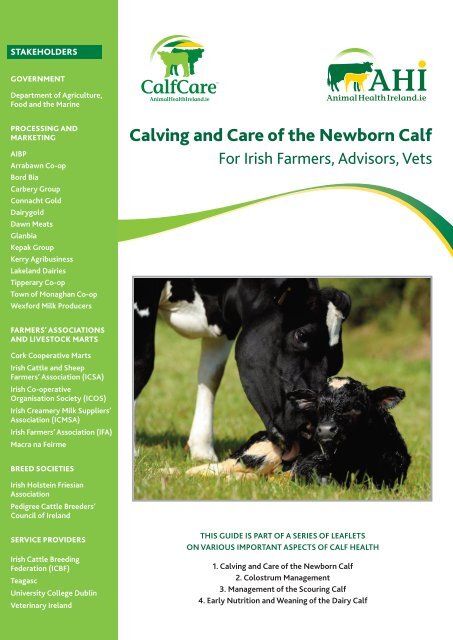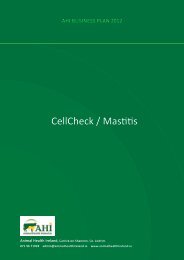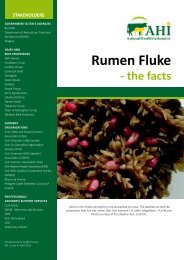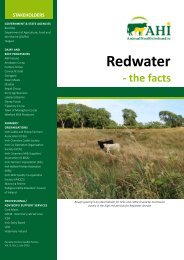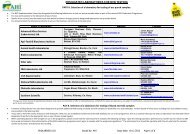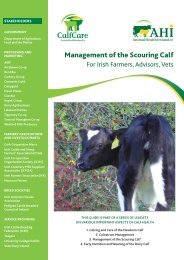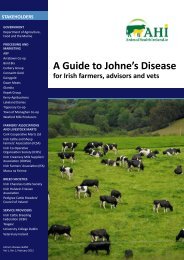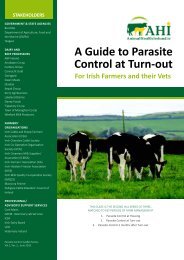Calving and Care of the Newborn Calf - Animal Health Ireland
Calving and Care of the Newborn Calf - Animal Health Ireland
Calving and Care of the Newborn Calf - Animal Health Ireland
Create successful ePaper yourself
Turn your PDF publications into a flip-book with our unique Google optimized e-Paper software.
3How can you MANAGE CALVINGS to reduce calving problems <strong>and</strong>calf losses?1Calve all heifers <strong>and</strong> cows in a calving unitCleancalving pens<strong>and</strong> housing tominimisedisease<strong>Calving</strong> facilities should be clean, well-bedded <strong>and</strong> well-illuminated <strong>and</strong> have an adequatesupply <strong>of</strong> clean water. They should be equipped with a self-locking restraining gate (preferablysuitable for Caesarean Section) <strong>and</strong> should not be used to accommodate sick cattle.Individual calving boxes are preferable. Depending on <strong>the</strong> precalving movement policy, <strong>the</strong>calving pattern <strong>and</strong> <strong>the</strong> residency time in <strong>the</strong> pen, at least one individual calving pen (4mby 4m) may be required per 25 cows.Well-managed, group-calving units (loose pens, pads, paddocks) can also provide suitable calvingaccommodation. (See AHI website www.animalhealthirel<strong>and</strong>.ie regarding issues on Johne's Disease <strong>and</strong> groupcalving facilities.)2Move pregnant animals to <strong>the</strong> calving unit before calving begins• Moving pregnant animals to <strong>the</strong> calving unit before calving begins reduces stress at calving, which can bea particular problem in heifers.• Inspect <strong>the</strong> animals near to calving (based on breeding/pregnancy detection records) at least twice daily,<strong>and</strong> move <strong>the</strong>m into <strong>the</strong> calving unit when you detect signs <strong>of</strong> impending calving (see below).• If a cow is already ‘sick to calve', when first observed, it may be better to wait until she has started to calve(waterbag or foetal hooves are visible) before moving her into <strong>the</strong> calving unit. This advice appliesparticularly in <strong>the</strong> case <strong>of</strong> heifers.Signs that calving is close:o s<strong>of</strong>tening <strong>of</strong> <strong>the</strong> pin boneligamentso swollen uddero dripping colostrum.‘Sick to calve’ signs to look for:o tail raisedo mucus at vulvao restless - st<strong>and</strong>ing <strong>and</strong> lyingfrequently.3Observe all calvings if possibleObserveall calvings ifpossible• If cows are 'sick to calve', keep a discreet eye on <strong>the</strong>m every two hours. Do not move,disturb or unnecessarily h<strong>and</strong>le cows during this period. Supervision does not implyintervention, as most calvings do not require assistance.• Keep a particularly close eye on high-risk calvings or calvings which are likely to beprolonged, e.g. overfat heifers, heifers in calf to a sire known to produce big calves, cowscarrying twins <strong>and</strong> cows with a history <strong>of</strong> milk fever.• <strong>Calving</strong> cameras can be a useful aid to reduce <strong>the</strong> workload involved in 24h calving supervision <strong>and</strong> toavoid disturbing <strong>the</strong> calving, particularly for heifers which are more sensitive to stress.• Evening or nightime feeding can reduce, although not eliminate, <strong>the</strong> number <strong>of</strong> night calvings.
44Intervene if calving is not progressing normallyInterveneonly whennecessaryAfter six hours (unless <strong>the</strong>re is anobvious reason for earlierintervention) <strong>of</strong> being ‘sick tocalve’ without <strong>the</strong> waterbag orfeet appearing, examine <strong>the</strong> birthpassage with a lubricated, glovedh<strong>and</strong>. (Dispose carefully <strong>of</strong> <strong>the</strong>gloves after calving).Depending on what you find:1. give more time to calve (calf normally presented <strong>and</strong>cow straining intermittently)2. intervene if possible (e.g. calf with head or legs down)3. ring your vet now (e.g. oversized calf, calf comingbackwards, dead or deformed calf, intertwined twins,twisted womb, smelly or bloody discharge).Attach ropes above <strong>the</strong> fetlocksIf in doubt, give <strong>the</strong> vet a call for advice, as rushing in toassist when <strong>the</strong> cervix <strong>and</strong> vulva are not fully open canbe as detrimental as waiting too long to intervene.If <strong>the</strong> calf hasn't been born two hours (three hours forheifers) after <strong>the</strong> waterbag or foetal hooves haveappeared, examine <strong>the</strong> birth passage <strong>and</strong> <strong>the</strong> calf witha lubricated gloved h<strong>and</strong>. (Dispose carefully <strong>of</strong> <strong>the</strong>gloves after calving).Set up calving jackIf <strong>the</strong> emergence <strong>of</strong> <strong>the</strong> waterbag or fetal hooves wasnot observed, as long as <strong>the</strong> cow is straining <strong>and</strong> makingprogress over half an hour, intervention is not required.Intervention is required where <strong>the</strong> calving is not likely toprogress fur<strong>the</strong>r at a normal rate without assistance orwhere <strong>the</strong> calf appears distressed (swollen tongue orhead, bluish gums, poor reflexes). Assistance may be in<strong>the</strong> form <strong>of</strong>:o lubricationo manual pulling <strong>of</strong> <strong>the</strong> calfo pulling <strong>of</strong> <strong>the</strong> calf with <strong>the</strong> help <strong>of</strong> <strong>the</strong> calving jack.Only pull when <strong>the</strong> cow is forcingA decision must be made as to when <strong>the</strong> degree <strong>of</strong>calving difficulty exceeds <strong>the</strong> skill <strong>of</strong> <strong>the</strong> operator <strong>and</strong>when to seek veterinary assistance.
55Improve your calving skills• The ability to deliver a live calf <strong>and</strong> healthy cow, atan assisted calving, can vary due to inadequateskills <strong>and</strong> lack <strong>of</strong> practice, as only a minority <strong>of</strong>cows require assistance <strong>and</strong> few <strong>of</strong> <strong>the</strong>se aredifficult calvings.• You can improve your calving skills by observinghow your local vet deals with a problem calving<strong>and</strong> discussing with him or her how to improveyour techniques.• Having good calving equipment (e.g. non-slipcalving jack, disinfected coloured calving ropes,lubricant, arm-length gloves) in <strong>the</strong> calving unitwill facilitate good calving technique. Colouredropes will ensure you don't lose <strong>the</strong> ropes in <strong>the</strong>straw bedding.Rotate <strong>the</strong> calf after <strong>the</strong> chest emergesTIPS:• ensure <strong>the</strong> cow is st<strong>and</strong>ing before attemptingto correct a wrongly presented calf• put ropes on above <strong>the</strong> fetlock, ensuring that<strong>the</strong> knots are not on <strong>the</strong> sides <strong>of</strong> <strong>the</strong> legs• only pull when <strong>the</strong> cow forces <strong>and</strong> relax <strong>the</strong>ropes when she relaxes• pull on alternate legs until <strong>the</strong> head emerges<strong>and</strong> rotate <strong>the</strong> calf after <strong>the</strong> chest emerges toprevent a hiplock.Check <strong>the</strong> calf for breathing <strong>and</strong> alertnessGood technique is particularly importantwhere a calving jack is used as it can causesevere injuries to both <strong>the</strong> cow <strong>and</strong> <strong>the</strong> calf ifused incorrectly.Clean jack <strong>and</strong> ropes directly after each calving to minimisedisease spread
6HOW CAN YOU BEST MANAGE YOUR NEWBORN CALVES?The ‘GOLDEN HOUR’ after calving.The first hour after calving is <strong>the</strong> most critical period in <strong>the</strong> entire life <strong>of</strong> <strong>the</strong> calf.This is when:1. resuscitation may be needed2. <strong>the</strong> dairy calf needs to be removed from <strong>the</strong> cow3. you can prevent navel ill.Colostrum needs to be fed within TWO HOURS after calving. (See AHI leaflet - 'ColostrumManagement' for fur<strong>the</strong>r details).Delaying any <strong>of</strong> <strong>the</strong>se jobs will result in increased risk <strong>of</strong> calf disease <strong>and</strong> death.<strong>Calf</strong> resuscitationMost calves don’t need resuscitation. However, high-risk calves from problem calvings will benefit fromresuscitative care during <strong>and</strong> immediately after calving. To identify calves requiring resuscitation you need tobe present at <strong>the</strong> calving <strong>and</strong> looking out for <strong>the</strong> predictive signs <strong>of</strong> calf distress.High risk calves requiring resuscitation can be identified:Before birth During birth After birthby <strong>the</strong> predicted likelihood <strong>of</strong> aproblem calving (premature,wrongly presented calf, twins,slow calving, tight calving, hardcalving)by large limbs, swollen tongueor head, bluish gums <strong>and</strong>muzzle, yellow/brown/redstained birth fluids <strong>and</strong> poorreflex response to pinchingbetween <strong>the</strong> hoovesby no breathing orgasping/bellowing, lying flat outunable to lift <strong>the</strong> head <strong>and</strong> slowto sit up, st<strong>and</strong> <strong>and</strong> to suckWhere you identify a high-risk calf before calving, you can begin resuscitation during calving once <strong>the</strong> calf’s chesthas emerged, for example, during a hiplock calving.First aid can be given to a high-risk calf without any equipment:• once <strong>the</strong> high-risk calf is born, suspend it upside-down for a short period <strong>of</strong> time (never longer than oneminute)• <strong>the</strong>n pour cold water over its head <strong>and</strong>/or stick a straw or finger into its nostrils• <strong>the</strong>n place it sitting upright on its chest• very weak, cold, wet, shivering calves should be dried <strong>of</strong>f <strong>and</strong> placed under an infra red lamp• ask your local vet regarding o<strong>the</strong>r options such as stimulant products or o<strong>the</strong>r aids.


